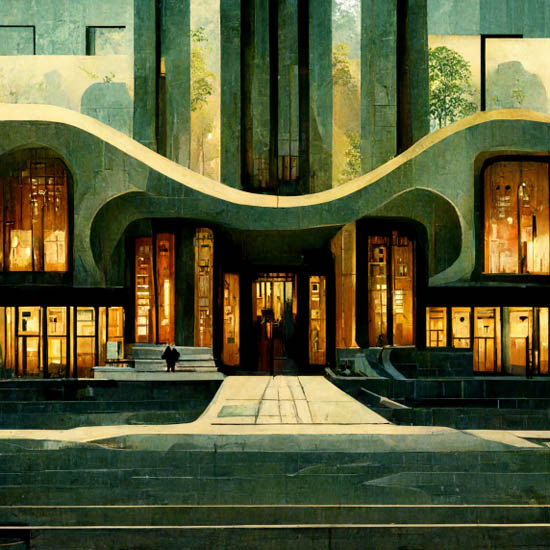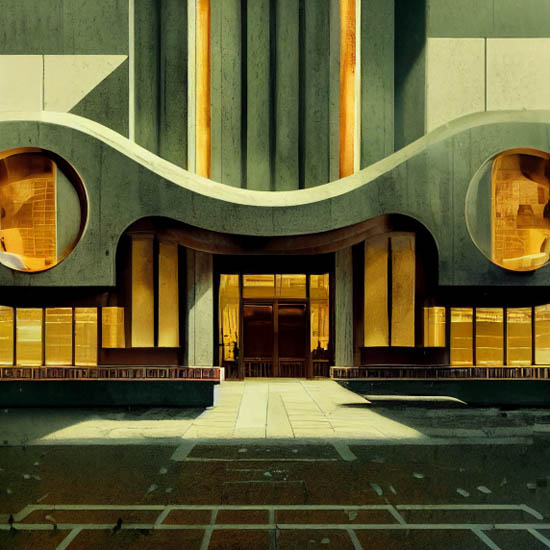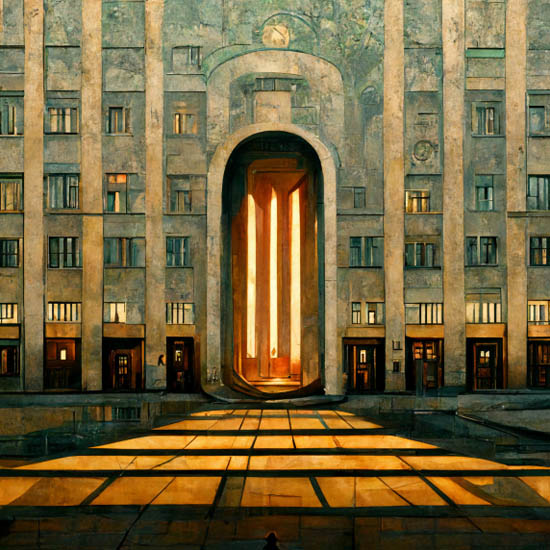Is there a place for AI design in real-world practice? asks Edward Crump
These days there are many peo ple popping up on my social media feeds with weird and wonderful CGI-esque imagesthat look like creations of the Grimm brothers. Upon seeing these for the umpteenth time, I decided to finally test for myself the newfound craze that is ‘AI design’. I created an account on Midjourney and embarked on creating the images that accompany this article.
Once registered, you need to enter what resembles a chatroom and essentially create a search using keywords. Rather than getting the familiar response from a conventional search engine — more words — the programme seeks to respond through a series of images.
To begin my search I considered that the Art Deco style is very ‘in-vogue’ these days. Lots of interior designs, particularly lending themselves to angular patterns, strong colours, curved forms and framed elements. I wanted to see what the AI thought about the future of Art Deco for architecture — Neo-Decoism, so to speak. Thus, I entered my keywords:
Building, Front Elevation, Street, Art Deco, Entrance Door, Cinematic Lighting, Trees, Autumn, People, Cars.
After pressing the search button, the software whirred away in the background and finally presented me with four options of images with characteristics of my search. I was then given a series of options inviting me to ask for further variations on a particular image or ‘upscale’ one of my choosing, to increase its size and detail.
While I have seen many people posting curiously realistic renders they claim were the result of their searching and refining process, which include buildings clad in piñata elements, neo-classical haystacks or structures that resemble tall strands of pale broccoli, the outputs of my efforts appeared to present themselves in a more artistic, textural fashion. Nonetheless, once you have received your result and overcome the thrill of what you have achieved with such ease, you do begin to zoom in and notice imperfections within the images, not unlike where a painter may intentionally blur their work at moments of precision – as if there is an unwillingness to give too much away by illustrating the finer details.
Having pressed all of the buttons to ensure I fully explored the software, what I can conclude is very interesting: firstly, you can’t just ‘Google’ a design. Now this may be obvious, but everything that is produced in this manner doesn’t respond to a particular site condition; this software merely produces a ‘realistic collage’, so to speak, based on keywords. Therefore as an act of design it relies on the literary skill of the ‘programmer’, and through the results embodying a sense of placelessness, it cannot be taken seriously in its present form as an act of considered real-world design.
That being said, I think it would be wrong to dismiss AI design completely. I found that, as a tool for generating ideas, it managed to succeed in creating a series of visuals that surprised me — that didn’t have any reasonable semblance to the images I had constructed cognitively when I wrote my keywords. To reflect how this process differs from how we design in professional practice, from experience I know a lot of ‘concept design research’ involves finding work from other practitioners (Pinterest, yep we all thought it!) and ‘creatively editing’ our preferred precedents in such a format that it fits the project we are working on. There is good reason for this. If such a design already exists in the real world, then it can most likely be constructed for the yet to be built project we are working on.
Whereas this process allows for touches of creativity and innovation — around the fringes of making a design work in a particular location or manipulating it slightly according to the project theme — it doesn’t allow for the ‘pure’ blank-canvas pie-in-the-sky ideas approach that is often heralded through architecture and design history (think Le Corbusier’s ‘Cartesian Skyscrapers’).
The most important act we can undertake as designers is to propose a vision of the world to give humanity something to believe in – a direction to work towards
In contrast to this process through precedent which could be argued is being extremely limiting, we have a tool where we can insert words or phrases that may be relevant to our project and it will generate ideas to allow us, as designers, to widen our field of view and challenge our existing constraints.
It is through this process of reflection and refocusing, therefore, that I believe the value lies. I think we can accept that professional practice has relied too heavily upon the ‘precedent’ approach to design creation and that has led to the frustrations outlined by Thomas Heatherwick (Heatherwick studio) in his recent speech in Singapore proclaiming that “we’re living through an epidemic of boringness.”
Does this mean that AI design is the silver bullet to this issue? Probably not. The process of taking these designs and converting them into feasible structures, which will then be ruthlessly value-engineered beyond any meaningful existence, suggests our wider political structures have a stronger influence upon the nullification of inspiration and the formation of deepset cognitive constraints. But it’s nice to dream, so who is to say why not?
At the end of the day, as tacitly suggested by Adam Curtis in his documentary ‘HyperNormalisation’ the most important act we can undertake as designers is to propose a vision of the world to give humanity something to believe in — a direction to work towards — and if AI design is part of this exercise, then there lies its true power and relevance to the “dull, flat, shiny, straight, inhuman” world we live in today.
Edward Crump is a University Tutor and award winning architectural designer with an interest in art and digital technology. @edthearch












